Fountain of Youth? These are the best and worst states for your skin
A recent study ranked states from best to worst for skin health across the U.S.
Where does your state rank for skin health? Scientists at No7 Beauty crunched the weather stats and ranked all 50 states from best to worst states for your epidermis.
In its first annual Skincare Index, the skincare and makeup company’s dermatologists determined that air quality, humidity and sun exposure are the most essential weather factors that impact your skin’s health.
7 best states for healthy skin
- Montana
- North Dakota
- Minnesota
- Iowa
- Nebraska
- Hawaii
- Massachusetts
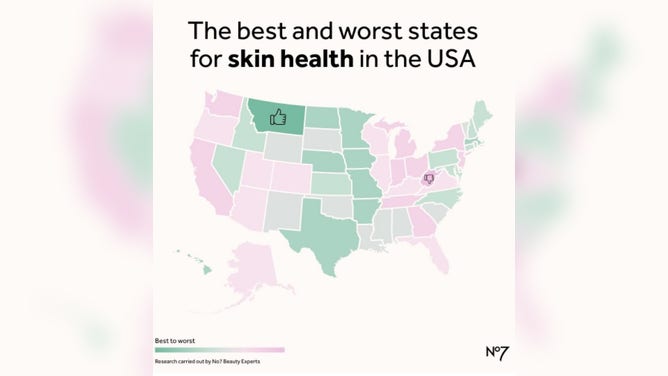
The healthiest states for your skin are in green and the least healthy are in pink.
7 worst states for healthy skin
50. West Virginia
49. Ohio
48. Indiana
47. California
46. Georgia
45. New York
44. Tennessee
Sun exposure: What is the perfect amount?
Humans need vitamin D from the sun for overall health but too much takes a toll on skin. According to a study published by Harvard Medical School, skin starts to convert the sun’s UV- B rays into vitamin D, helped out by the liver and kidneys. The vitamin enables the body to absorb calcium to keep our bones healthy and strong.
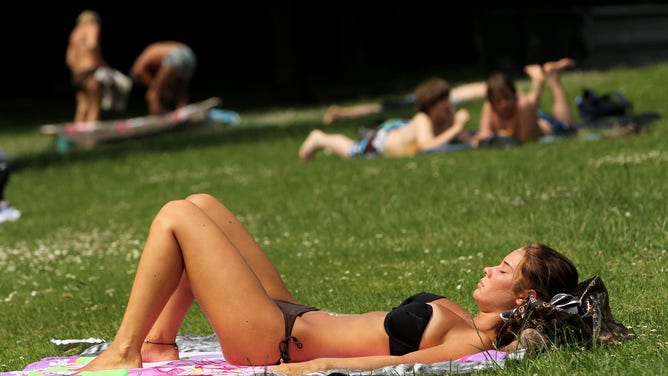
A woman sunbathing
(Sean Gallup/Getty Images / Getty Images)
A study published in the American Journal of Critical Nurition showed a 50-77% decrease in cancer rates like Hodgkins lymphoma, breast, ovarian, colon, pancreatic and prostate cancers when study participants doubled to quadrupled their vitamin D intake.
More sun though, causes damaging sunburns, redness and inflammation. Not so obvious, ultraviolet light damages skin cells, elastic fibers and lowers collagen levels which are signs of aging skin. And the CDC says sun can damage unprotected skin in as little as 15 minutes. For every 100,000 Americans in 2018, 22 reported new skin melanomas and two people died from the cancer.
OZONE LAYER REGULATIONS WILL PREVENT 443 MILLION CASES OF SKIN CANCER IN THE US, EPA SAYS
During the summer, humans only need 10-15 minutes of sun on arms and legs to provide all the vitamin D heathy bodies need stated a study.
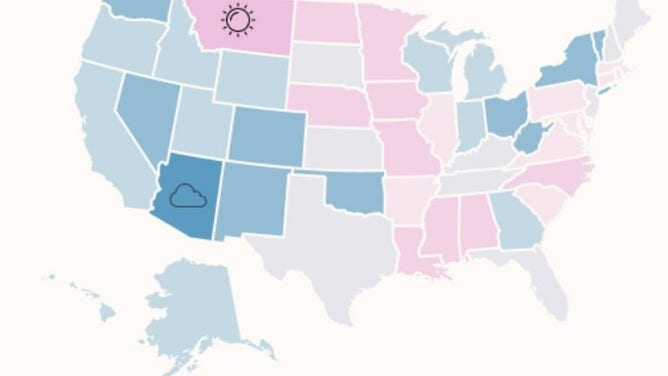
The map shows the states with the optimal number of hours of sun per year in pink and the least optimal in blue.
No7 experts determined that on average get 2,700 hours of sun per year. States closest to that amount scored highest on the skin scale. Montana scored the top spot for the amount of sunlight received and Arizona scored at the bottom. Alaska, where some cities go through months without sun, scored third from bottom.
ALASKAN TOWN OF Utqiaġvik FINALLY SEES THE SUN AFTER 65 DAYS
Air quality
Utah scored the worst for air quality. Multi-day temperature inversions (warm air in the atmosphere and cold, stable air at the surface, commonly in winter) traps exhaust and wood smoke at the surface. West Virginia, the worst state for skin health, also scores high for air pollution and poor air quality.
7 CITIES WITH AMERICA'S WORST AIR
Acne and skin inflammation are linked to poor air quality. Air pollution aggravates skin allergies like dermatitis, eczema and psoriasis. Ozone and smog also prematurely age skin and depletes its repairing antioxidants.
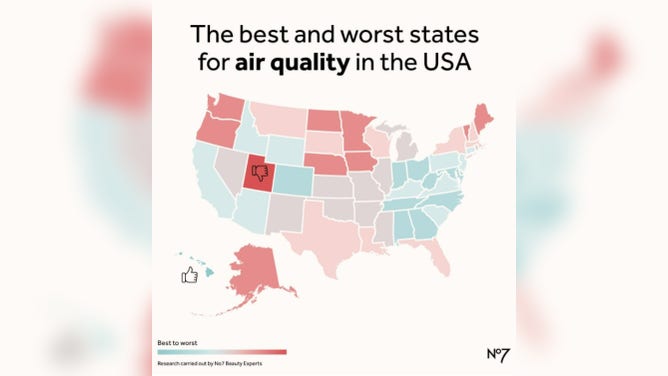
Blue represents the best states for air pollution for skin and dark pink the worst.
(No7 Beauty)
While Hawaii sits at the top spot for best air quality, its sunny weather kept the state out of the top seven states for best skin.
Ideal humidity
Too much and not enough humidity can also irritate skin. Dry air makes the skin more susceptible to irritants and diseases. "Excess humidity causes pores to open making them susceptible to dirt, oil and allergens which can trigger acne, skin breakouts, eczema and allergic reactions," stated the Index.
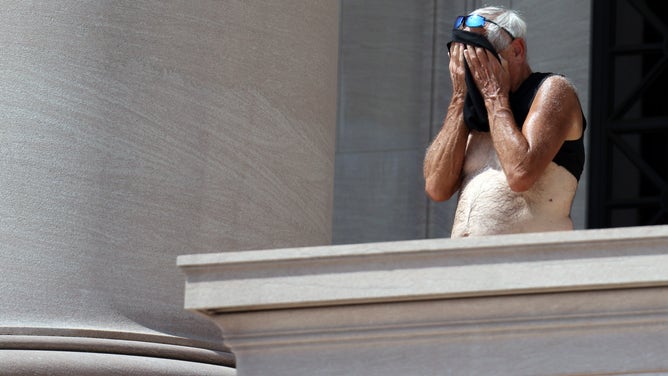
High temperatures and humidity open pores and makes skin more prone to irritants.
( Kevin Dietsch/Getty Images / Getty Images)
Scientists determined that an average humidity of 65% (measured in the morning and evening) was optimal for skin. The states coming closest to 65% average relative humidity scored highest. Keep in mind, relative humidity is a function of both the temperature and the amount of water in the air.
Warmer states like Florida scored lower because hot temperatures lead to moisture loss (sweat and dehydration) which can dry out skin making it red and irritated.
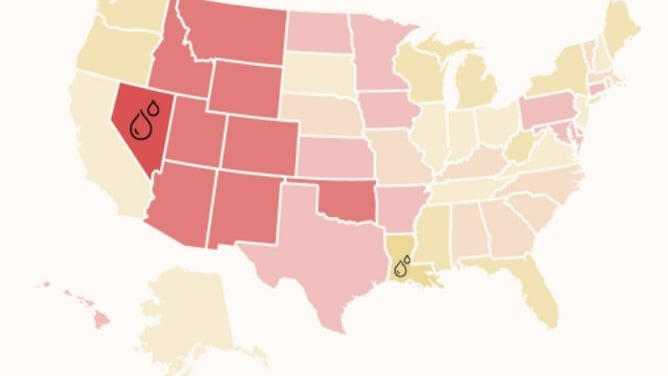
Humidity and temperature data highlights the healthiest states in dark pink and the least healthy in buff.
"Looking at temperatures specifically, higher temperatures and higher humidities can be a problem for people with atopic dermatitis or rosacea as the heat and humidity can trigger flare-ups," said Dr. Mike Bell, Head of Science Research for No7 Beauty.
Louisiana scored worst for humidity for skin and Nevada (data taken in Reno) the best.
Perfect temperature
"The optimum environmental temperature for skin (and for the human body) is around 64.4 °F – 71.6 °F," stated Bell. "This allows for optimum heat exchange between the body (at 98.6 °F) and the outside."
No7 did not directly account for temperature in the Index. That’s one of the reasons why Montana with a chilly average yearly temperature of 42.7 °F scored so high while West Virginia, last place overall, has an average yearly temperature of 51.8 °F, closer to optimum.
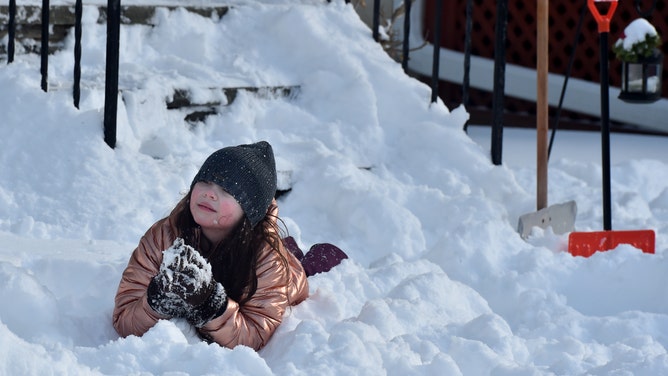
A girl trying to shield her skin from the cold.
(Aimee Dilger/SOPA Images/LightRocket via Getty Images / Getty Images)
What you can do to even the odds
Skin products like sunscreen and moisturizer can protect your skin from the elements no matter what state you live in. Clothing, boots, hats and gloves can physically protect skin from the environment.